
PeopleImages/E+/GettyImages
Got metal? If you’re part of the fast-growing body-piercing trend, there’s a good chance you have a few barbells, hoops or studs taking up residence on your skin and cartilage.
With everything from ears and facial piercings to genital, navel and nipple piercings, the places on your body that you can poke holes in are pretty much endless. But one area that seems to be gaining piercing popularity and losing its taboo status is the nipple.
Risks of Getting Your Nipple Pierced
While the art of body piercing is not new, the increase in popularity is. That’s why more doctors and piercing experts are sharing the risks associated with this form of body art. A 1999 review from the Journal of General Internal Medicine found that these were the most common complications with nipple piercings:
- Redness and swelling
- Drainage
- Infection
- Bleeding
- Cyst formation
- Large scars
- Trauma or tear
1. Infection
Nipples can be pierced using a piercing gun to force the nipple ring through the tissue or using a needle to create a channel to insert the nipple ring. Both methods call for introducing a foreign metal object directly into the skin and can result in an infection if the equipment isn’t properly sterilized or proper aftercare isn’t enforced.
A worst-case scenario can result in the transmission of hepatitis B or C or even HIV if the person performing the procedure uses nonsterile equipment for the piercing. Using an unclean needle can also increase your risk of contracting tetanus, says Tsippora Shainhouse, M.D., Los Angeles-based dermatologist.
Before piercing, speak to your doctor about any precautions you can take to protect yourself from infection (see below for more tips). And afterward, watch for any changes in the nipple tissue that may indicate infection after piercing. It can take six to 12 months for the piercing to completely heal, with an average of nine months.
Read more: 4 Ways to Identify Signs of Viral Infection
2. Allergic Contact Dermatitis
If you have a sensitivity or allergy to certain metals and introduce them into your tissue, you can develop a rash called contact dermatitis. Dr. Shainhouse says nickel is the biggest culprit and a fairly common allergen.
The rash may not appear until days or weeks after the piercing and may remain for weeks even if you remove the nipple ring. Because the skin is red and irritated, many people mistake a rash for an infection.
Thus, you should see your doctor to ensure a proper diagnosis. If the doctor determines you have contact dermatitis, you should immediately remove the nipple ring and treat the rash with cortisone cream. Do not reinsert the nipple ring until you have determined a type of metal you can wear without causing an allergic reaction.
3. Breast Cellulitis
Breast cellulitis is an infection that results from bacteria introduced to the pierced area. Left untreated, cellulitis can develop into a painful abscess and cause you to run a fever.
If the abscess does not respond to antibiotic treatment, it will have to be surgically drained by placing an incision across the main part of the abscess and allowing the pus to drain from the body.
Again, if you notice redness, swelling, tenderness, pain or fever, or if the piercing site oozes clear or yellow fluids, talk with your doctor for a proper diagnosis and course of treatment.
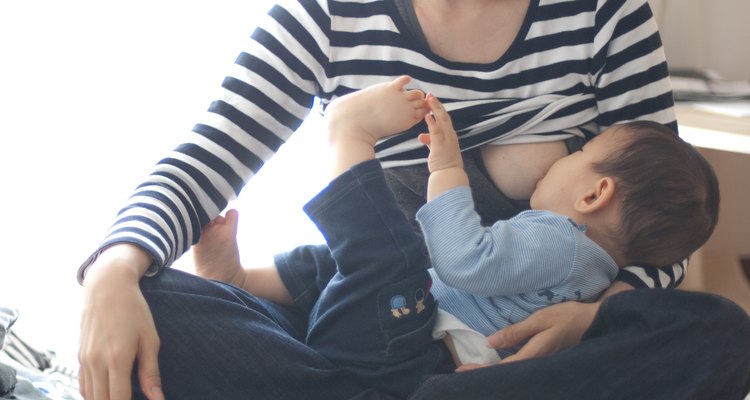
iryouchin/E+/GettyImages
4. Breastfeeding Complications
The channel created by the piercing may become infected if it doesn’t properly drain while breastfeeding. To help avoid infection, remove the nipple ring during breastfeeding, but be aware that milk may squirt from the channels.
If you wish to leave the nipple ring in place while breastfeeding, make sure the nipple ring is securely tightened before each breastfeeding session to prevent the infant from swallowing or choking on the jewelry.
Read more: Foods Breastfeeding Mothers Should Avoid
Tips If You Plan to Get Your Nipple Pierced
Now that you know the risks, are you still game to get your nipple pierced? If so, there are things you can do to ensure that you have a safe, healthy and enjoyable experience.
- Do your research on your options for piercing. Look for a business that’s reputable and has a license to perform the procedure. If you’re not sure, ask.
- Check the facility for cleanliness. Janet Prystowsky, M.D., a board-certified dermatologist based in New York City, says to make sure the room is clean and that all the instruments are sterile (again, don’t be afraid to ask what their sterilization practices are).
- Ensure that the person doing the procedure washes his or her hands and wears new, sterile gloves. Dr. Prystowsky says the jewelry should also be new and sterilized.
- Be aware that the nipples are an area with a high density of nerve endings, says Donna Hart, M.D., dermatologist with Westlake Dermatology & Cosmetic Surgery in Austin, Texas. So piercing this area can be more painful than other areas of the skin.
- Make sure the jewelry you’re choosing will work for your body. “Nickel is a common allergen found in many metal alloys,” says Dr. Hart. Because of this, Dr. Hart suggests sticking to posts made of surgical steel, titanium, platinum or nickel-free gold.
Nipple Piercing Aftercare Instructions
After the procedure, Dr. Prystowsky says you’ll want to keep the area dry, avoid touching it and wear loose clothing that doesn’t rub up against it. She also says to avoid swimming until the site is fully healed.
To clean the piercing site, wash your hands thoroughly with soap and warm water, and then use a saline solution and cotton swab or cotton ball to gently clean the area, carefully removing any crusts that form.
Be prepared for a lengthy healing process. “The nipples can take nine to 12 months to fully heal after piercing,” says Dr. Hart. But the hole can close up within minutes to days after removal. That is why Dr. Shainhouse says it’s best to have the first jewelry changing performed by the piercing salon.
When to See a Doctor
Pay attention to any areas that may look infected. Signs of infection can include:
- Redness and swelling
- Area is hot to the touch
- Fever
- Rash
- Odor
- Body aches
- Green, yellow or brown discharge
- Fatigue
If the area is painful or you’re not sure if the piercing is healing properly, see a doctor immediately.
Related Articles

How to Change Pierced Earrings
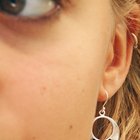
How Long Do You Keep Your Earrings in ...
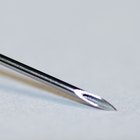
Types of Piercing Needles

Homemade Recipe to Disinfect a Piercing

Facts on Nose Piercings

What to Do When a Nose Ring Falls Out

How Soon Can I Change My Belly Button ...

Side Effects of Veet Waxing Strips

How to Care for a Rook Piercing
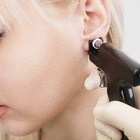
What If They Make a Mistake When ...

Reactions to Nose Piercings
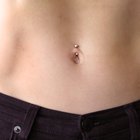
How to Remove a Navel Piercing

How to Remove a Labret Piercing

How to Remove Starter Earrings for ...

How to Pierce Your Navel

How to Drain a Cheek Piercing

How to Get Rid of a Piercing That Won't ...

How to Stop Pierced Ears From Seeping

What Is Bio-Flex Made of for Piercings?

Ear Piercing & Sports
References
Writer Bio
Sara Lindberg, B.S., M.Ed., is a freelance health and fitness writer. She holds a Bachelor’s of Science degree in exercise science and a Master's degree in counseling. She’s spent her life educating people on the importance of health, wellness, mindset and mental health. She specializes in the mind-body connection, with a focus on how our mental and emotional wellbeing impact our physical fitness and health.